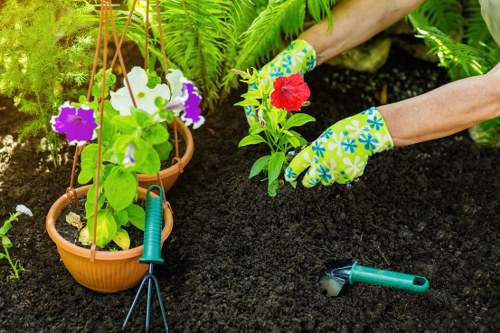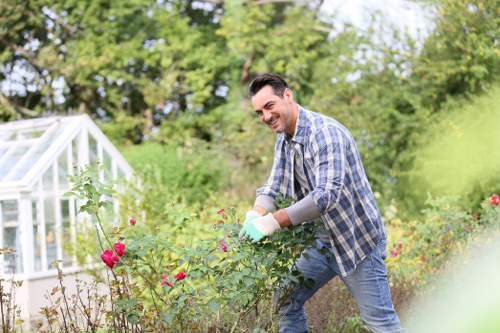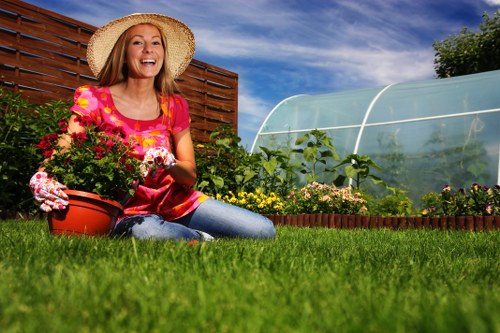Landscaping in Mowing Sucks: Rethinking Lawn Care for a Healthier Environment
Introduction to Modern Landscaping

Landscaping plays a crucial role in enhancing the aesthetic appeal of both residential and commercial properties. However, traditional landscaping practices, particularly frequent mowing, have come under scrutiny for their environmental impact and overall effectiveness. In this article, we explore why mowing sucks in the context of modern landscaping and discuss alternative approaches that promote sustainability and natural beauty.
Over the years, mowing has been a staple in lawn maintenance, symbolizing a well-kept garden or a pristine yard. But as our understanding of ecology and sustainable practices deepens, it's time to question whether this method is truly beneficial. This discussion delves into the drawbacks of conventional mowing and offers insights into more eco-friendly landscaping techniques.
The environmental implications of frequent mowing extend beyond just aesthetics. Traditional lawn care often relies on gasoline-powered mowers, contributing to air pollution and greenhouse gas emissions. Additionally, the removal of natural grass clippings disrupts the nutrient cycle, depriving the soil of essential organic matter. These factors collectively highlight the need for a paradigm shift in how we approach lawn maintenance.
The Environmental Impact of Mowing

Air Pollution and Carbon Footprint
Gasoline-powered mowers are significant contributors to air pollution. They emit carbon monoxide, volatile organic compounds, and nitrogen oxides, all of which degrade air quality and pose health risks to humans and wildlife. By reducing or eliminating the use of such mowers, homeowners can substantially lower their carbon footprint and promote a healthier environment.
Furthermore, the noise pollution generated by traditional mowers disrupts local ecosystems. Wildlife, especially birds and insects, rely on quiet environments for communication and survival. The constant hum of a mower can interfere with these natural processes, leading to unintended ecological consequences.
Adopting electric or manual mowing alternatives can mitigate these issues. Electric mowers produce fewer emissions and operate more quietly, making them a more sustainable choice. Manual options like reel mowers eliminate emissions altogether, offering a zero-impact solution for lawn maintenance.
Soil Health and Ecosystem Balance

Nutrient Cycling Disruption
Grass clippings left on the lawn play a vital role in nutrient cycling. They decompose naturally, returning essential nutrients like nitrogen, phosphorus, and potassium to the soil. Regular removal through mowing deprives the soil of these nutrients, necessitating increased use of chemical fertilizers. This practice not only harms soil health but also leads to water pollution through runoff.
Moreover, frequent mowing can lead to soil compaction, reducing its ability to absorb water and support plant roots. Compacted soil is less hospitable to beneficial microorganisms and earthworms, which are essential for maintaining soil structure and fertility. By minimizing mowing, homeowners can foster richer soil ecosystems that support robust plant growth.
Embracing natural landscaping techniques, such as xeriscaping or creating native plant gardens, can enhance soil health. These methods reduce the need for mowing and promote biodiversity, creating a more resilient and sustainable landscape.
Alternatives to Traditional Mowing

Embracing Native Plants and Ground Covers
One effective alternative to traditional mowing is the use of native plants and ground covers. Native species are well-adapted to the local climate and soil conditions, requiring less water, fertilizer, and maintenance. They provide habitats for local wildlife, including pollinators like bees and butterflies, fostering a healthy ecosystem.
Ground covers, such as clover, moss, or sedum, can effectively replace traditional grass lawns. These plants require minimal mowing and maintenance while offering unique textures and colors to the landscape. By reducing the reliance on grass, homeowners can create more diverse and visually interesting outdoor spaces.
Additionally, incorporating mixed plant beds and meadow areas can enhance the overall biodiversity of the landscape. These areas support a variety of plant and animal species, contributing to a balanced and sustainable environment.
Benefits of Reducing Mowing in Landscaping

Environmental Advantages
Reducing mowing frequency has several positive environmental impacts. It lowers carbon emissions, decreases noise pollution, and promotes healthier soil ecosystems. Less mowing also means reduced dependency on chemical fertilizers and pesticides, which can have harmful effects on surrounding waterways and wildlife.
Moreover, having a diverse landscape with native plants increases resilience against pests and diseases. These natural systems are better equipped to handle environmental stresses, such as droughts or heavy rainfall, making them more sustainable in the long term.
From an economic perspective, minimizing mowing can lead to significant cost savings. Lower maintenance requirements translate to reduced labor and equipment expenses, allowing homeowners to allocate resources to other aspects of their property or invest in further sustainable practices.
Implementing Sustainable Landscaping Practices
Permaculture and Sustainable Design
Permaculture principles focus on designing landscapes that mimic natural ecosystems, promoting sustainability and self-sufficiency. By integrating diverse plant species, efficient water management systems, and natural pest control methods, homeowners can create thriving landscapes with minimal intervention.
Implementing rain gardens, swales, and composting areas are practical steps towards a sustainable landscape. These features help manage stormwater runoff, enhance soil fertility, and reduce the need for external inputs, fostering a more harmonious relationship with the environment.
Furthermore, selecting plant varieties that require less water and are resistant to local pests can greatly reduce maintenance efforts. This approach not only conserves resources but also enhances the overall beauty and functionality of the landscape.
Case Studies: Success Stories in Minimal Mowing Landscaping
Residential Transformations
Many homeowners have successfully transitioned to low-mow or no-mow landscapes, experiencing enhanced curb appeal and reduced maintenance. For instance, replacing traditional lawns with native plant gardens has not only beautified properties but also attracted beneficial wildlife, creating vibrant and lively outdoor spaces.
In urban settings, community gardens and public parks have embraced sustainable landscaping, serving as models for others to follow. These spaces demonstrate the feasibility and benefits of minimizing mowing while fostering community engagement and environmental stewardship.
These case studies highlight the versatility and effectiveness of alternative landscaping approaches, encouraging more individuals to consider sustainable options for their own properties.
Overcoming Challenges in Reducing Mowing

Addressing Aesthetic Concerns
One of the primary concerns with reducing mowing is the perceived decline in visual appeal. Traditional lawns are often associated with neatness and order, making it challenging to transition to more diverse planting schemes. However, thoughtful design and plant selection can create aesthetically pleasing landscapes that rival traditional lawns in beauty and charm.
Incorporating pathways, focal points, and varied plant heights and textures can enhance the overall design, making the landscape visually engaging without the need for constant mowing. Seasonal blooms and changing foliage also contribute to a dynamic and ever-evolving outdoor space.
Educating homeowners about the long-term benefits and immediate visual rewards of sustainable landscaping can help alleviate aesthetic concerns and encourage adoption of alternative practices.
Maintenance Tips for Low-Mow Landscapes

Regular Monitoring and Care
While low-mow landscapes require less maintenance than traditional lawns, they still benefit from regular monitoring and care. Pruning, weeding, and mulching are essential tasks that help maintain plant health and appearance. Establishing a seasonal maintenance schedule ensures that the landscape remains vibrant and well-organized.
Incorporating organic mulches, such as bark or straw, can suppress weeds, retain soil moisture, and improve soil fertility. Additionally, using natural pest control methods, like introducing beneficial insects or applying neem oil, can manage pest populations without harmful chemicals.
Investing in quality soil amendments and compost can further enhance plant growth and resilience. Healthy soil is the foundation of a thriving landscape, reducing the need for excessive watering and fertilization.
Community and Cultural Shifts Towards Sustainable Landscaping
Promoting Awareness and Education
Shifting towards sustainable landscaping requires a collective effort from communities and stakeholders. Promoting awareness about the environmental and economic benefits of reducing mowing can inspire more individuals to adopt eco-friendly practices. Educational programs, workshops, and community initiatives play a vital role in disseminating knowledge and encouraging action.
Furthermore, local governments and organizations can support sustainable landscaping by offering incentives, grants, or resources to homeowners and businesses willing to make the transition. Collaborative efforts can accelerate the adoption of greener practices, leading to broader environmental benefits.
Celebrating success stories and showcasing exemplary sustainable landscapes can also motivate others to follow suit, fostering a culture of environmental responsibility and innovation.
Long-Term Benefits of Minimizing Mowing

Economic Savings and Increased Property Value
Minimizing mowing and adopting sustainable landscaping practices can lead to significant economic savings over time. Reduced maintenance needs translate to lower labor and equipment costs, freeing up resources for other investments or personal use. Additionally, sustainable landscapes often require less water and fewer chemical inputs, further decreasing ongoing expenses.
Moreover, properties with well-designed, eco-friendly landscapes tend to have higher market values. Prospective buyers are increasingly valuing sustainable features, recognizing their long-term benefits and lower maintenance requirements. Investing in sustainable landscaping can thus be a valuable addition to a property's overall worth.
The environmental benefits also extend to personal well-being. Green, diverse landscapes contribute to improved mental health, providing serene and stimulating outdoor spaces that enhance the quality of life.
Getting Started with Sustainable Landscaping
Steps to Transition Your Landscape
- Assessment: Evaluate your current landscape to identify areas where mowing can be reduced or eliminated.
- Planning: Design a sustainable landscape that incorporates native plants, ground covers, and diverse plant species.
- Implementation: Gradually replace traditional grass with selected alternatives, ensuring proper soil preparation and plant placement.
- Maintenance: Establish a maintenance routine that focuses on pruning, weeding, and natural pest control.
- Education: Stay informed about sustainable practices and adapt your landscape as needed to enhance its resilience and beauty.
By following these steps, homeowners can effectively transition to a more sustainable and low-maintenance landscape, reaping both environmental and economic rewards.
If you're ready to transform your lawn into a sustainable oasis, contact us today to begin your journey towards a greener future.
Conclusion: Embracing a Sustainable Future
Making the Sustainable Choice
Reevaluating traditional mowing practices is a crucial step towards more sustainable and environmentally friendly landscaping. By reducing mowing frequency and embracing alternative landscaping methods, homeowners can significantly lower their environmental impact, enhance their property's beauty, and enjoy economic benefits.
Adopting sustainable landscaping is not just a trend but a necessary shift in how we interact with our environment. It fosters biodiversity, improves soil health, and creates more resilient ecosystems that can withstand the challenges of climate change.
As we move towards a more sustainable future, rethinking practices like frequent mowing is essential. Embrace the change, explore alternative landscaping options, and contribute to a healthier planet.
Take the first step today and book your service now to transform your landscape into a sustainable masterpiece.